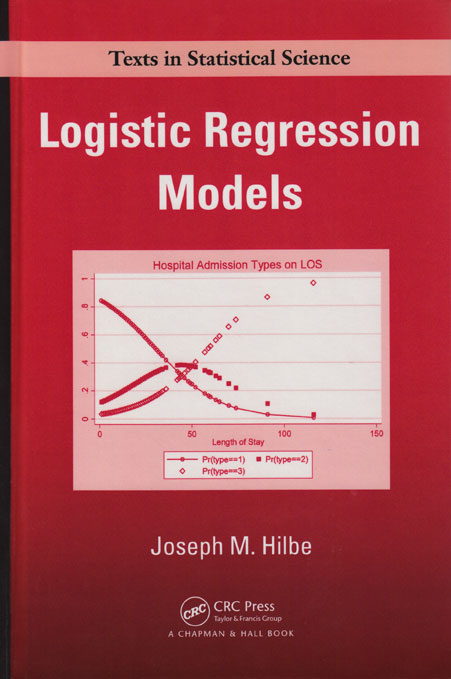Logistic Regression Models, by Joseph Hilbe, arose from Hilbe’s course in logistic regression at statistics.com. The book includes many Stata examples using both official and user-written commands and includes Stata output and graphs.
Hilbe begins with simple contingency tables and covers fitting algorithms, parameter interpretation, and diagnostics. The later chapters include models for overdispersion, complex response variables, longitudinal data, and survey data. The final chapter describes exact logistic regression, available in Stata 10 with the new exlogistic command. Hilbe does not oversimplify controversial issues, like interactions and standardized coefficients.
The prerequisite for most of the book is a working knowledge of multiple regression, but some sections use multivariate calculus and matrix algebra.
Hilbe is coauthor (with James Hardin) of the popular Stata Press book Generalized Linear Models and Extensions. He also wrote the first versions of Stata’s logistic and glm commands.
The fourth printing has been revised: examples in the book now use Stata version 11 code in place of earlier version code, where applicable.
Preface
CHAPTER 1 INTRODUCTION
The Normal Model
Foundation of the Binomial Model
Historical and Software Considerations
Chapter Profiles
CHAPTER 2 CONCEPTS RELATED TO THE LOGISTIC MODEL
2 × 2 Table Logistic Model
2 × k Table Logistic Model
Modeling a Quantitative Predictor
Logistic Modeling Designs
Experimental Studies
Observational Studies
Prospective or Cohort Studies
Retrospective or Case–Control Studies
Comparisons
Exercises
R Code
CHAPTER 3 ESTIMATION METHODS
Derivation of the IRLS Algorithm
IRLS Estimation
Maximum Likelihood Estimation
Exercises
R Code
CHAPTER 4 DERIVATION OF THE BINARY LOGISTIC ALGORITHM
Terms of the Algorithm
Logistic GLM and ML Algorithms
Other Bernoulli Models
Exercises
R Code
CHAPTER 5 MODEL DEVELOPMENT
Building a Logistic Model
Interpretations
Full Model
Reduced Model
Assessing Model Fit: Link Specification
Box–Tidwell Test
Tukey–Pregibon Link Test
Test by Partial Residuals
Linearity of Slopes Test
Generalized Additive Models
Fractional Polynomials
Standardized Coefficients
Standard Errors
Calculating Standard Errors
The z-Statistic
p-Values
Confidence Intervals
Confidence Intervals of Odds Ratios
Odds Ratios as Approximations of Risk Ratios
Epidemiological Terms and Studies
Odds Ratios, Risk Ratios, and Risk Models
Calculating Standard Errors and Confidence Intervals
Risk Difference and Attributable Risk
Other Resources on Odds Ratios and Risk Ratios
Scaling of Standard Errors
Robust Variance Estimators
Bootstrapped and Jackknifed Standard Errors
Stepwise Methods
Handling Missing Values
Modeling an Uncertain Response
Constraining Coefficients
Exercises
R Code
CHAPTER 6 INTERACTIONS
Introduction
Binary × Binary Interactions
Interpretation—as Odds Ratio
Standard Errors and Confidence Intervals
Graphical Analysis
Binary × Categorical Interactions
Binary × Continuous Interactions
Notes on Centering
Constructing and Interpreting the Interaction
Interpretation
Standard Errors and Confidence Intervals
Significance of Interaction
Graphical Analysis
Categorical × Continuous Interactions
Interpretation
Standard Errors and Confidence Intervals
Graphical Representation
Thoughts about Interactions
Binary × Binary
Continuous × Binary
Continuous × Continuous
Exercises
R Code
CHAPTER 7 ANALYSIS OF MODEL FIT
Traditional Fit Tests for Logistic Regression
R2 and Pseudo-R2 Statistics
Deviance Statistic
Likelihood Ratio Test
Hosmer–Lemeshow GOF Test
Hosmer–Lemeshow GOF Test
Classification Matrix
ROC Analysis
Information Criteria Tests
Akaike Information Criterion—AIC
Finite Sample AIC Statistic
LIMDEP AIC
SWARTZ AIC
Bayesian Information Criterion (BIC)
HQIC Goodness-of-Fit Statistic
A Unified AIC Fit Statistic
Residual Analysis
GLM-Based Residuals
Raw Residual
Pearson Residual
Deviance Residual
Standardized Pearson Residual
Standardized Deviance Residual
Likelihood Residuals
Anscombe Residuals
m-Asymptotic Residuals
Hat Matrix Diagonal Revisited
Other Influence Residuals
Conditional Effects Plot
Validation Models
Exercises
R Code
CHAPTER 8 BINOMIAL LOGISTIC REGRESSION
Exercises
R Code
CHAPTER 9 OVERDISPERSION
Introduction
The Nature and Scope of Overdispersion
Binomial Overdispersion
Apparent Overdispersion
Simulated Model Setup
Missing Predictor
Needed Interaction
Predictor Transformation
Misspecified Link Function
Existing Outlier(s)
Relationship: Binomial and Poisson
Binary Overdispersion
The Meaning of Binary Model Overdispersion
Implicit Overdispersion
Real Overdispersion
Methods of Handling Real Overdispersion
Williams’ Procedure
Generalized Binomial Regression
Concluding Remarks
Exercises
R Code
CHAPTER 10 ORDERED LOGISTIC REGRESSION
Introduction
The Proportional Odds Model
Generalized Ordinal Logistic Regression
Partial Proportional Odds
Exercises
R Code
CHAPTER 11 MULTINOMIAL LOGISTIC REGRESSION
Unordered Logistic Regression
The Multinomial Distribution
Interpretation of the Multinomial Model
Independence of Irrelevant Alternatives
Comparison to Multinomial Probit
Exercises
R Code
CHAPTER 12 ALTERNATIVE CATEGORICAL RESPONSE MODELS
Introduction
Continuation Ratio Models
Stereotype Logistic Model
Heterogeneous Choice Logistic Model
Adjacent Category Logistic Model
Proportional Slopes Models
Proportional Slopes Comparative Algorithms
Modeling Synthetic Data
Tests of Proportionality
Exercises
CHAPTER 13 PANEL MODELS
Introduction
Generalized Estimating Equations
GEE: Overview of GEE Theory
GEE Correlation Structures
Independence Correlation Structure Schematic
Exchangeable Correlation Structure Schematic
Autoregressive Correlation Structure Schematic
Unstructured Correlation Structure Schematic
Stationary or m-Dependent Correlation Structure Schematic
Nonstationary Correlation Structure Schematic
GEE Binomial Logistic Models
GEE Fit Analysis—QIC
QIC/QICu Summary–Binary Logistic Regression
Alternating Logistic Regression
Quasi-Least Squares Regression
Feasibility
Final Comments on GEE
Unconditional Fixed Effects Logistic Model
Conditional Logistic Models
Conditional Fixed Effects Logistic Models
Matched Case–Control Logistic Model
Rank-Ordered Logistic Regression
Random Effects and Mixed Models Logistic Regression
Random Effects and Mixed Models: Binary Response
Alternative AIC-Type Statistics for Panel Data
Random-Intercept Proportional Odds
Exercises
R Code
CHAPTER 14 OTHER TYPES OF LOGISTIC-BASED MODELS
Survey Logistic Models
Interpretation
Scobit-Skewed Logistic Regression
Discriminant Analysis
Dichotomous Discriminant Analysis
Canonical Linear Discriminant Analysis
Linear Logistic Discriminant Analysis
Exercises
CHAPTER 15 EXACT LOGISTIC REGRESSION
Exact Methods
Alternative Modeling Methods
Monte Carlo Sampling Methods
Median Unbiased Estimation
Penalized Logistic Regression
Exercises
Conclusion
APPENDIX A: Brief Guide to Using Stata Commands
APPENDIX B: Stata and R Logistic Models
APPENDIX C: Greek Letters and Major Functions
APPENDIX D: Stata Binary Logistic Command
APPENDIX E: Derivation of the Beta Binomial
APPENDIX F: Likelihood Function of the Adaptive Gauss–Hermite Quadrature Method of Estimation
APPENDIX G: Data Sets
APPENDIX H: Marginal Effects and Discrete Change


